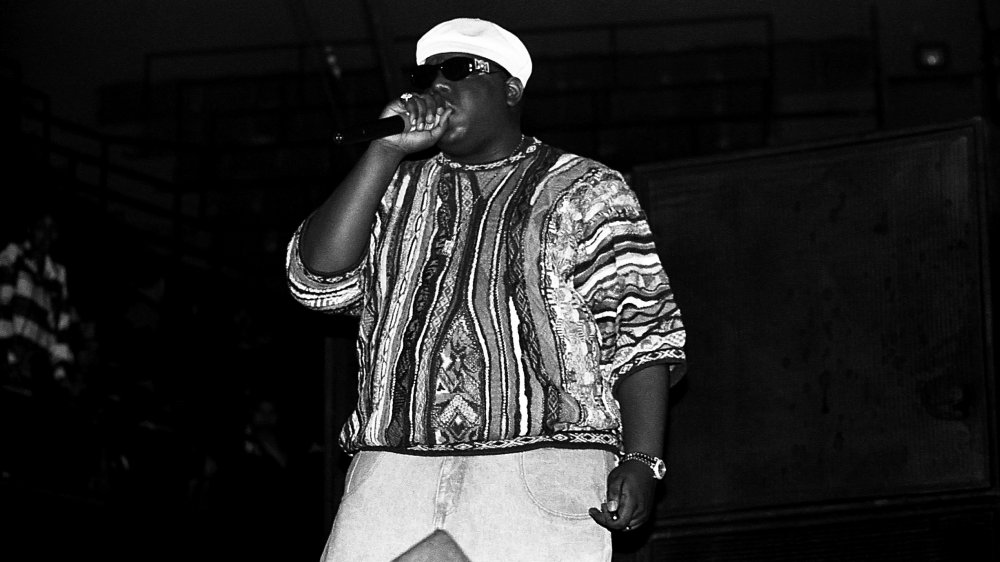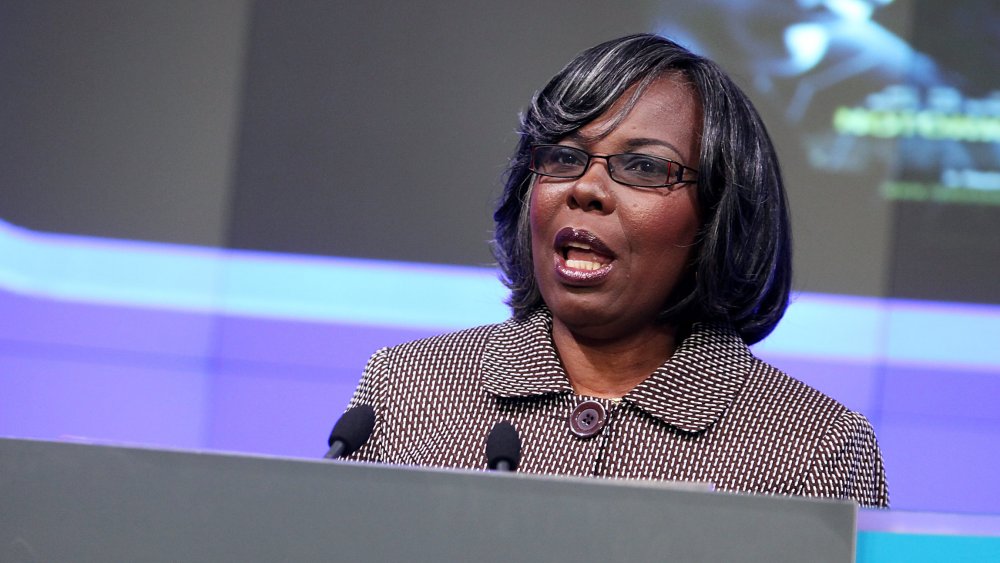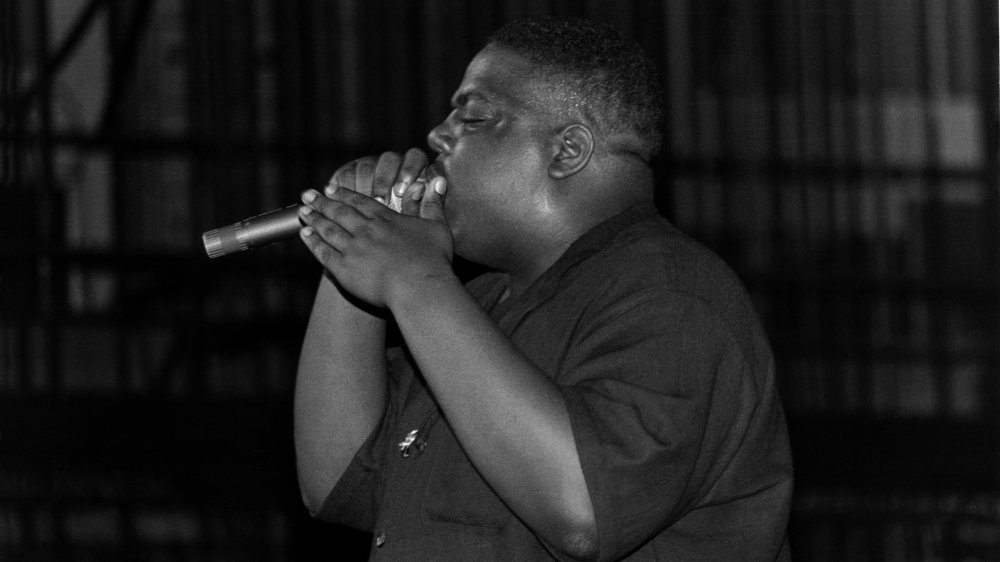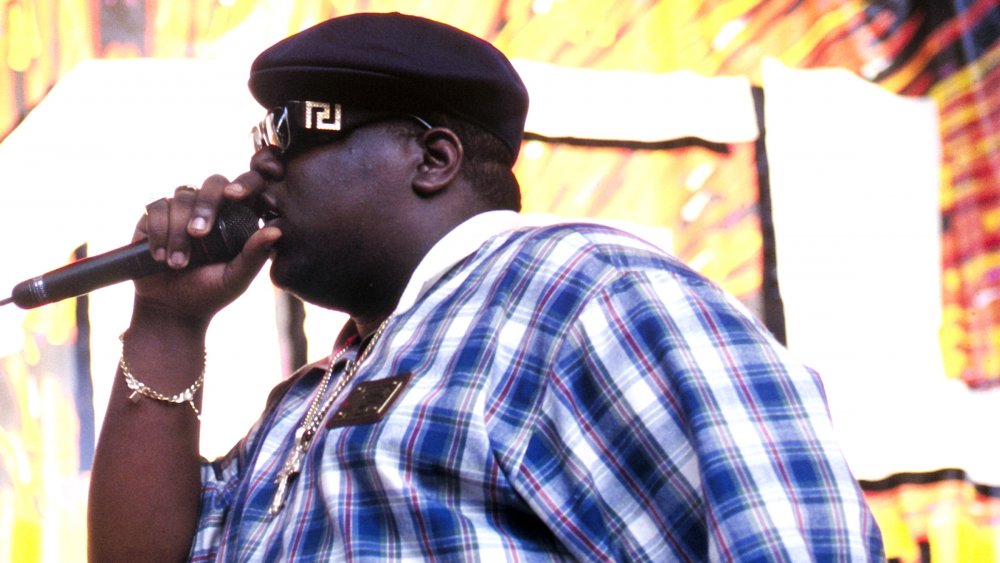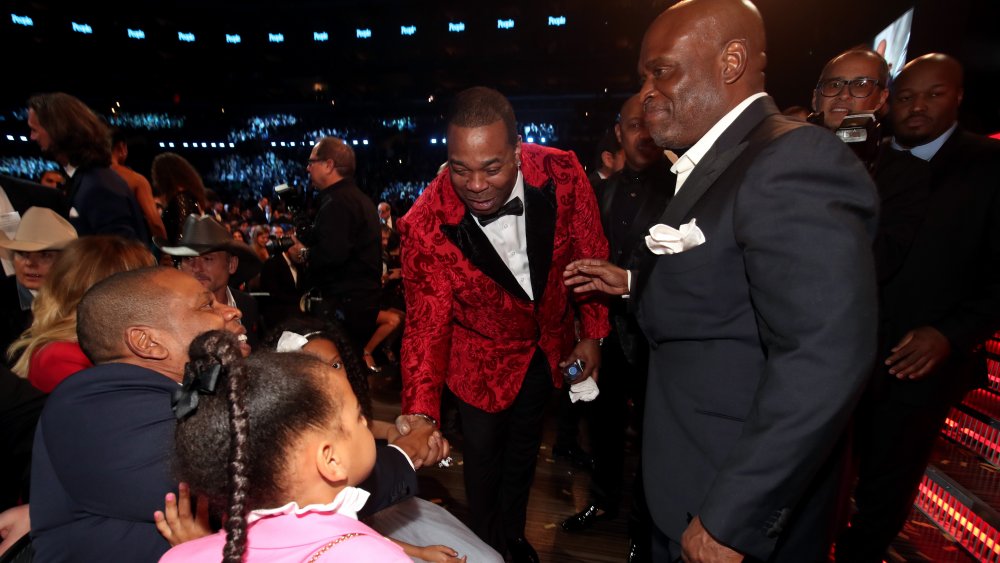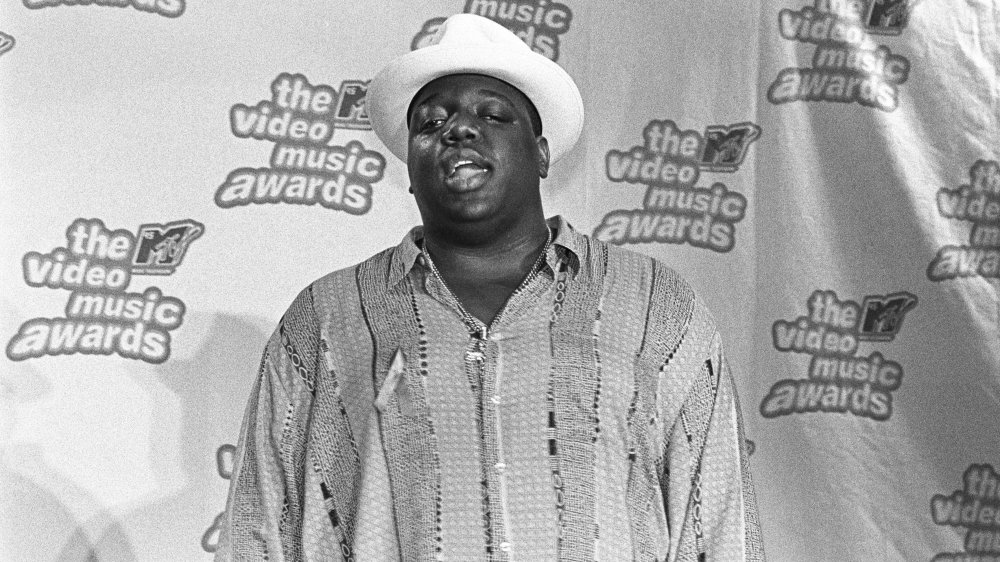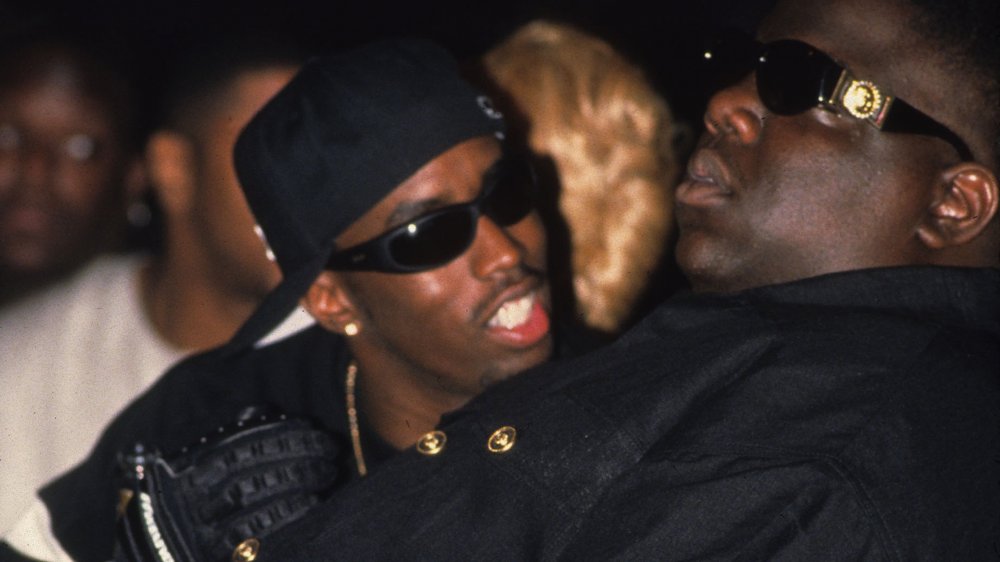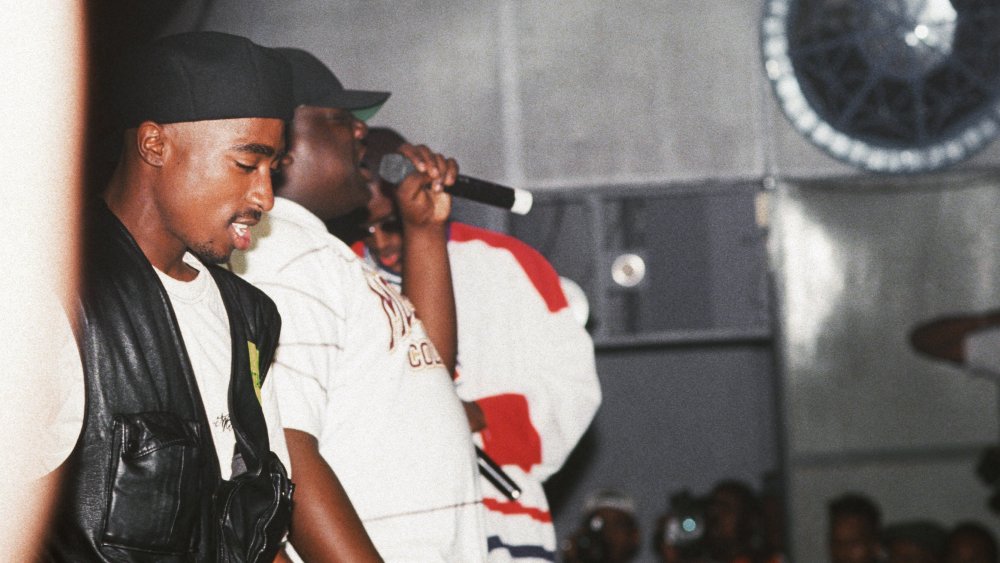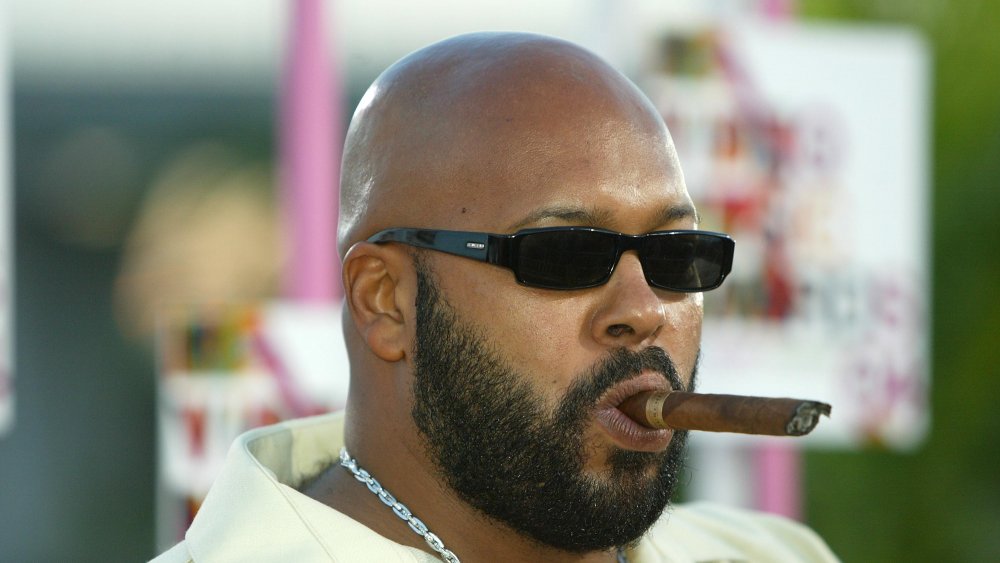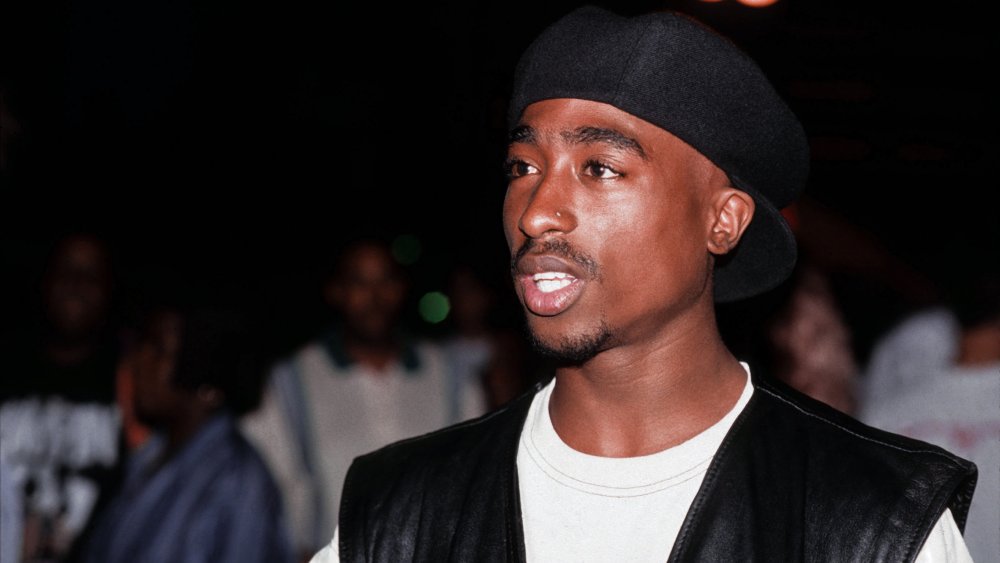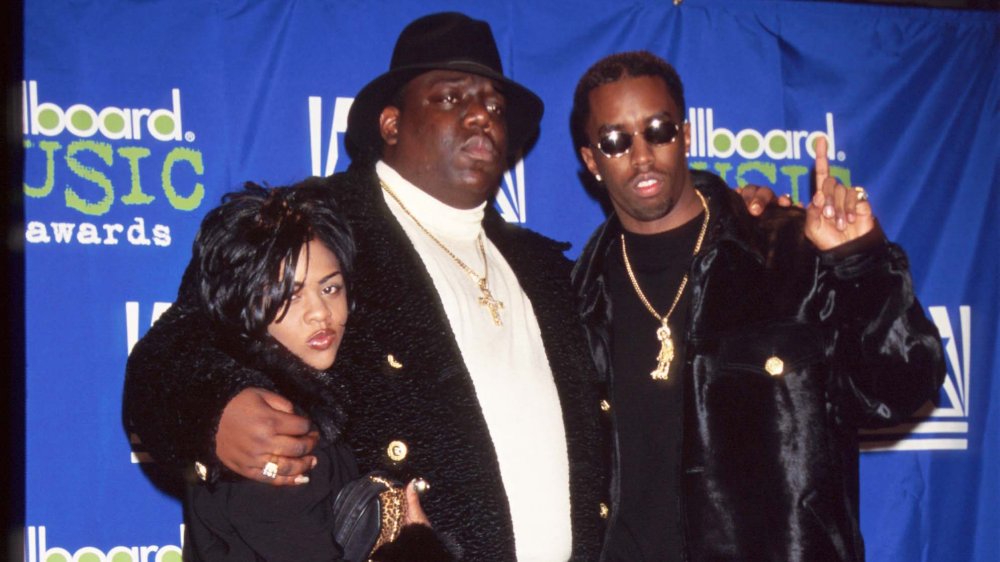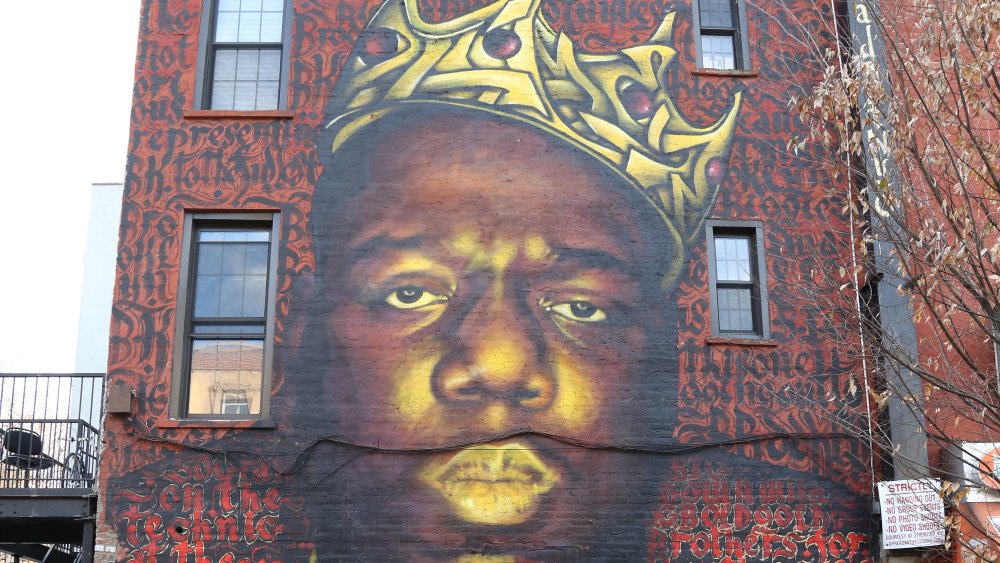The Tragic Real-Life Story Of The Notorious B.I.G.
When Congressman Hakeem Jeffries quoted one of his district's most famous residents during Donald Trump's impeachment hearings in January 2020, it illustrated the influence The Notorious B.I.G., born Christopher Wallace, has left on American culture. It has been 23 years since his death, but the hip-hop superstar's meteoric rise to fame in the early and mid-1990s and all too sudden murder left a legacy not only in Jeffries' district or in hip-hop culture but in modern-day urban Americana. Despite recording only two albums during his lifetime, his second released less than three weeks after his murder, The Notorious B.I.G., also known as Biggie Smalls, became one of the greatest musicians of his era and helped reshape the young hip-hop music genre.
Though Wallace's legacy was cemented with his skills as an emcee, it was a mountainous climb for the Brooklynite to become a legend. His early life saw him deal with the effects of living without a father during the heights of New York's crack cocaine epidemic. Even after finally hitting it big, his short career as a star was marred with legal troubles, coastal rivalries, and a feud with a former friend that ended in both their untimely murders. Here is the tragic real-life story of one of the greatest emcees of all time, The Notorious B.I.G.
The Notorious B.I.G. grew up in a one-parent household
The stereotypical story for a hip-hop artist usually includes a single-mother household, a childhood of living in a low-income area of a major city, and growing up around gang violence and/or drug dealing. The Notorious B.I.G. was no exception. Christopher George Latore Wallace was born on May 21, 1972, in Brooklyn, New York, to Voletta Wallace (pictured above), a Jamaican preschool teacher, and Selwyn George Latore, a welder and Jamaican politician.
When the future hip-hop star was just a toddler, his father left the family, leaving Voletta to care for her son as a single mother. According to Classic Hip Hop Magazine, Selwyn had already married another woman by the time he left his wife and son. On his song "The What" from his debut album, The Notorious B.I.G mentioned his father's disappearance from his life: "Ready to die, why I act that way? Pop duke left mom duke, the f*ggot took the back way."
Though he was born and raised in Brooklyn, Biggie's Jamaican ancestry occasionally came out in his music. He used Jamaican slang words such as "bloodclaat" and "lambsbread" on his songs and also appeared as a featured artist on the remix to the song "Dolly My Baby" by popular Jamaican deejay Super Cat. The music video for his song "One More Chance" featured popular Jamaican dancehall and reggae singer, Patra.
The Notorious B.I.G. struggled with his weight throughout his life
Long before he donned the names "Biggie Smalls" and "The Notorious B.I.G.," Wallace was big in another way. He struggled with his weight going all the way back to his elementary school days, which earned him his childhood nickname "Big." He eventually incorporated this into his emcee name. Fifteen years after his murder, the Los Angeles County Coroner's Office released his autopsy report, which indicated, per CNN, that Wallace weighed 395 pounds at the time of his death. The coroner wrote he was "morbidly obese," according to NME.
At times, Wallace's weight played to his advantage in his life. Aside from using it as his emcee names, The Notorious B.I.G. and Biggie Smalls, he also discussed his weight in his songs. One of Wallace's most successful songs was his second single from his first album, "Big Poppa." In an early recording when he was still underground, "Guaranteed Raw," the teenage emcee referred to himself as "the heavyset brother from Fulton Street." In 1994, in an unreleased verse for the song "Runnin' (Dying to Live)" by his friend and soon-to-be rival Tupac Shakur, Biggie wrote the lyrics, "Run from the police picture that, n***a I'm too fat I f*** around and catch an asthma attack." An asthma inhaler was found in his pocket during his autopsy, The Atlantic reports, indicating that the lyric wasn't fiction.
The Notorious B.I.G. became a drug dealer
According to an interview he gave to The New York Times in 1994, Wallace entered New York's drug-dealing scene at the age of 12. His mother worked as a preschool teacher during the day and attended night school, leaving little time to look after her son or notice his new career. In the interview, Voletta Wallace said that she was unaware of her son's activities and only learned through his music. "I found out about my son and his little antics through his music and through magazines," she said. "I read this thing and said, 'Huh? I never knew.'"
Wallace said he dealt close to his home, on Fulton Street between St. James Place and Washington Avenue, while his mother worked during the day. He also said that many of his buyers personally knew him and his mother: "My customers were ringing my bell, and they would come up on the steps and smoke right here. They knew where I lived; they knew my moms."
The preteen Wallace had entered the drug world at the height of New York's crack epidemic. According to a 1989 New York Times piece analyzing the epidemic, studies found that in 1986, there were about 182,000 regular users of the drug. (Wallace would have been 14 at the time.) By 1988, that number had more than tripled to about 600,000. The article also stated that in 1988, 38 percent of the year's 1,867 murders had to do with drugs.
The Notorious B.I.G. dropped out of high school at 17
Voletta wanted her son to attend the Roman Catholic Bishop Loughlin Memorial High School, a private school. The young Wallace went but eventually transferred to George Westinghouse Career and Technical Education High School. Notably, the school's alumni included some of the top rappers of the era, DMX, Jay-Z, and Busta Rhymes. During an interview with Fuse, Busta Rhymes (pictured above, center) reminisced on his time in high school with The Notorious B.I.G. as a classmate: "Big wasn't really into rhyming in school. I never seen him really rhyme in school. [...] I didn't know Biggie rhymed in school 'cause in school, we was cuttin' a lot of class and we was smokin' a lot of weed and bullsh*t."
In an interview with Vibe, Voletta Wallace discussed her son's time in high school. "Christopher did very well in high school; it's just that he talked back a lot," Voletta said. "He was a smart-a**."
She recalled one episode when her son asked her how much a garbage collector made. When he learned that, on average, garbage collectors made more than teachers, he bragged about it to his teacher, who'd previously insulted Big by telling him and the class that some of them would end up garbage collectors. Despite being a good student and having classmates who shared his interest in hip-hop, the teenage Wallace often skipped school. At the age of 17, he dropped out.
Multiple arrests and jail time
After dropping out of school, Big became a full-time drug dealer and occasional rapper on the streets of his neighborhood. An example of his early hip-hop talents was captured on video as early as 1989, when he was 17. Unfortunately for Wallace, his new career often led to trouble with the authorities. According to Biography, the same year his famous neighborhood freestyle was recorded, he was arrested on weapons possession charges and given five years of probation. The next year, he was arrested for a probation violation. In 1991, while in North Carolina, he was busted for dealing cocaine and spent nine months in jail while trying to make bail for his release.
Even after making it big as a hip-hop superstar, legal trouble seemed to always follow The Notorious B.I.G. Throughout 1996, while he was working on his second album, Wallace was in the police's crosshairs. In March, he was sentenced to 100 hours of community service after being arrested for chasing two autograph-seekers and allegedly threatening to kill them. Later that year, officers found four automatic weapons and 50 grams of marijuana in a raid of his New Jersey home. During the summer of '96, he was charged for allegedly beating and robbing a friend of a concert promoter in New Jersey, and that fall, he was arrested again in Brooklyn for smoking marijuana in his car.
Early hype, first child, and continued drug dealing
Following nine months locked up in North Carolina for dealing cocaine, Wallace released a demo. Though this would seem to indicate a change and a desire to take music more seriously, Wallace didn't think much of music as a career, saying, "It was fun just hearing myself on tape over beats" to The Source (via Biography).
Still, his skills and potential were undeniable. In March 1992, Wallace was featured in The Source's column about unsigned, talented rappers. Donning the name "Biggie Smalls" after the character of the same name in the 1975 film Let's Do It Again, Wallace was one of the top underground rappers in the city. This caught the attention of Uptown Records producer and executive Sean "Puff Daddy" Combs, who attempted to sign a deal with the young rapper but was soon out of Uptown Records after a falling-out with founder Andre Harrell. By the middle of 1992, Combs started his own label, Bad Boy Records, and made Biggie one of his first big acts on the label.
While Combs worked to get attention to his label and his new stars, Biggie began to worry about money, as he'd had his first child, a girl named T'yanna, in August 1993 with his high school sweetheart. Biggie went back to dealing drugs in order to support his new family, but he was soon forced to stop by Combs.
Biggie's friendship with Tupac Shakur and his first album
While working on his first album as a member of Bad Boy Records, Biggie came across one of the top artists in the world, Tupac Shakur. Tupac had already released two critically and commercially successful albums by 1993, and the pair grew close as Shakur acted as a mentor and older brother figure to the up-and-coming rapper. According to Vice, Wallace would sleep on Tupac's couch when he traveled to Los Angeles, and Shakur would spend time in Biggie's neighborhood when he was in Brooklyn.
At one point, Wallace questioned whether he should stay with Combs and Bad Boy Records, to which Shakur responded, "Nah, stay with Puff. He will make you a star." Shakur also gave advice to Wallace on his first album, saying, "If you want to make your money, you have to rap for the b*tches. Do not rap for the n***as," Shakur said. "The b*tches will buy your records."
On September 13, 1994, Ready to Die was released to the public. Within two months, the album certified gold. Ready to Die was lauded for the "semi-autobiographical tales from his wayward youth" and was seen as New York returning to the forefront of hip-hop after the late '80s and early '90s were dominated by the Los Angeles/West Coast area. Tupac's advice seemed to work, as Wallace's first Top 10 hit song came in March 1995 with the love jam, "Big Poppa," peaking at No. 6, per Billboard.
The end of B.I.G.'s friendship with Tupac
On November 29, 1994, Tupac Shakur was shot multiple times in an act of armed robbery in the Quad Studios lobby. Wallace and others were upstairs waiting for the arrival of the rapper. Following the shooting, Shakur accused Combs and Wallace of orchestrating everything, ending their friendship.
First, a little context: Back in 1991, former N.W.A. member Dr. Dre and Suge Knight (pictured above) united to form Death Row Records in Los Angeles. The label's early success saw the West Coast take the reins from the East Coast as hip-hop's center. Dan Charnas, a music history associate professor at New York University's Clive Davis Institute, discussed the rivalry to AM New York: "The [West Coast] artists felt that when they came to New York, they didn't receive the same acceptance and admiration as when New York artists came to L.A., because the West Coast's [artists] were more popular, simply from a sales perspective, than anyone at the time on the East Coast."
Only two days after he was shot, Tupac was convicted of first-degree sexual abuse and was sentenced to 18-54 months in prison. This was the main reason why he was in New York when he was shot, and it led to another major event of this period: Suge Knight posted $1.4 million to get the troubled rapper out of jail and quickly signed him to Death Row.
Tupac Shakur's murder
At the Source Awards in August 1995, Knight took a not-so-subtle shot at Sean Combs, insinuating that Combs was taking attention from his artist in his award acceptance speech. Death Row rapper Snoop Dogg also had a contentious moment at the show, asking the audience, "the East Coast don't got no love for Dr. Dre or Snoop Dogg?"
Following his signing to Death Row Records that autumn, Tupac released the song "Hit Em' Up," a diss track toward his former friend The Notorious B.I.G and other people associated with Bad Boy Records, in which he also claimed to have slept with B.I.G.'s wife, singer Faith Evans. Evans later denied this to MTV. In the music video of "2 of Amerikaz Most Wanted" featuring Snoop Dogg, exaggerated actors were hired to play Biggie and Puffy in a sketch.
The continued East Coast/West Coast rivalry came to a violent climax on the night of September 7, 1996, when Suge Knight and Tupac Shakur were shot in a drive-by shooting in Las Vegas. Tupac died six days later. According to Faith Evans, Biggie called her the night Tupac died, and she said his voice was "low and small" and that he had been crying. She told Slate that her husband said this: "Something ain't right, Faye. Sh*t got f*cked up somewhere along the way. But that was my n***a."
Biggie was left Wheelchair-bound following a car accident
While working on his second album, Life After Death, Wallace and his friend, rapper Lil' Cease, were involved in a near-fatal car crash. After being arrested for smoking marijuana in the autumn of 1996, the duo had to obtain a rental car. The car, a Chevrolet Lumina, was known for having brake problems. This frightened Cease, but Wallace ignored his friend's objections. According to Classic Hip Hop Magazine, the duo almost hit the dealer heading out of the rental lot before crashing the car on the rainy highway, leading to a broken leg for Wallace and broken jaw for Lil' Cease.
In an interview Lil' Cease gave to VladTV, Cease said that the injury forced Wallace to spend three months in the hospital and required six months of therapy to recover. The incident also influenced the lyrics on Life After Death, according to Cease, who said that the injury and time in the hospital was a "reality check" for B.I.G.
On the song, "The Long Kiss Goodbye," The Notorious B.I.G. rapped about the incident, saying, "Ya still tickle me, I used to be as strong as Ripple be / Til Lil' Cease crippled me," as Cease was the driver the day of the accident. The accident also forced Biggie to use a cane to get around. This can be seen in the music video for his single "Hypnotize," made days before his murder.
The Notorious B.I.G.'s unsolved murder
Six months after the murder of his one-time friend and rival Tupac Shakur, The Notorious B.I.G. traveled to Los Angeles to promote the release of his second album and record the music video for his single, "Hypnotize." While in L.A., Wallace told San Francisco's KYLD-FM that his high profile made him concerned about his safety. Unfortunately, his concern would be well-warranted.
On March 7, while B.I.G. was presenting an award at the 1997 Soul Train Music Award Show, boos could be heard, illustrating the continued anger of the coastal feuding. The next night, he and his entourage, including Sean Combs, Lil' Cease, his wife Faith Evans, and others, attended an after-party hosted by Vibe Magazine and Qwest Records. During the early hours of March 9, Biggie was in the front seat of his ride as he was leaving the party. In an event eerily similar to Tupac's murder, the SUV was stopped at a red light when another vehicle rode beside them and opened fire into the SUV, hitting B.I.G. four times.
Wallace was pronounced dead at Cedars-Sinai Medical Center about a half-hour after the drive-by shooting at only 24. Like the death of Tupac, the murder has yet to be solved, though Voletta Wallace told The Mercury News she believes that the Los Angeles Police Department knows who killed her son. Life After Death, The Notorious B.I.G.'s second album, was released 16 days later to critical and commercial acclaim.
